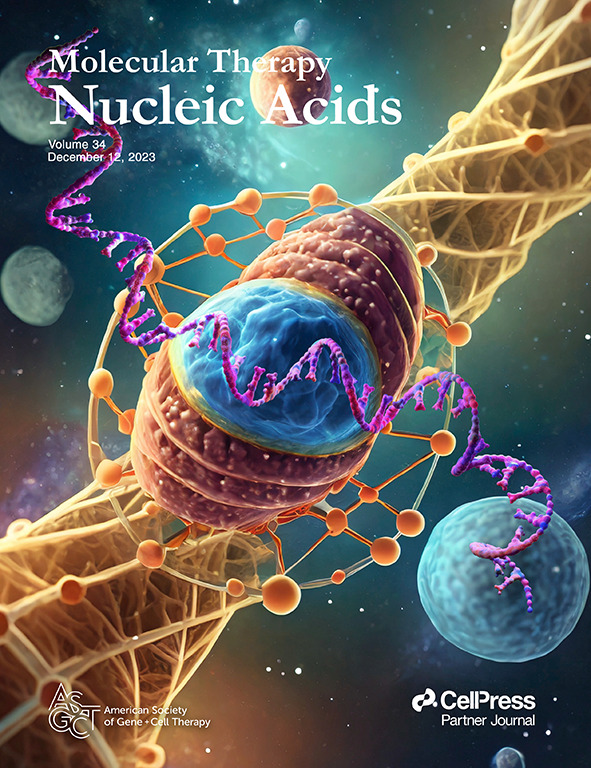利用 Gapmer ASO 靶向 KCNA2 的杂合显性负变异,治疗耐药性癫痫
IF 6.5
2区 医学
Q1 MEDICINE, RESEARCH & EXPERIMENTAL
引用次数: 0
摘要
最近在一名患有癫痫的婴儿身上发现了该基因的一个错义突变 c.1220C>G。该基因编码 K1.2 亚基,通过四聚体组装形成电压门控钾通道(VGKC)。基因突变导致高度保守基序的氨基酸发生变化,变为 P407R。功能表征显示,突变的 K1.2_P407R 亚基形成了功能缺失通道,并抑制了 K1.2 和 K1.1 通道的活性。K1.2_P407R 亚基与 Shaker 亚家族的其他神经元电压门控钾通道的异源四聚体组装可能会导致复极化钾电流的普遍缺失,并可能是癫痫发作易感性增强的潜在原因。事实上,在出生后早期大鼠皮质神经元或基因工程 hESC 衍生神经元中表达人 K1.2_P407R 会导致动作电位持续时间和早期后去极化(EAD)延长,这与钾电流减少有关。我们假设,针对 c.1220C>G 突变的 Gapmer 反义寡核苷酸 (ASO) 将选择性地降解突变体 mRNA,同时允许剩余的野生型(WT)亚基形成功能性通道。作为原理验证,将封装在脂质纳米颗粒中的 Gapmer 运送到大脑皮层神经元中,可选择性地抑制 K1.2_P407R 而不是 WT 蛋白的表达,从而逆转动作电位持续时间的加宽,消除 EAD 并导致钾电流的整体增加。本文章由计算机程序翻译,如有差异,请以英文原文为准。
Targeting heterozygous dominant negative variant of KCNA2 using Gapmer ASO for the treatment of drug-resistant epilepsy
A missense mutation c.1220C>G of gene was recently identified in an infant with epilepsy. encodes K1.2 subunits that form voltage-gated potassium channels (VGKC) via tetrameric assembly. The mutation results in amino acid change P407R at the highly conserved motif. Functional characterization revealed that mutant K1.2_P407R subunits formed loss-of-function channels and suppressed both K1.2 and K1.1 channel activities. Hetero-tetrameric assembly of the K1.2_P407R subunits with other neuronal voltage-gated potassium channels of Shaker subfamily could lead to general deficit of repolarizing potassium current and potentially underlie the enhanced seizure susceptibility. Indeed, expression of human K1.2_P407R in early postnatal rat cortical neurons or genetically engineered hESC-derived neurons disclosed broadening of action potential duration and early afterdepolarization (EAD), associating with reduced potassium current. We hypothesize that Gapmer antisense oligonucleotides (ASOs) targeted to c.1220C>G mutation will selectively degrade the mutant mRNA while allowing the remaining wild-type (WT) subunits to form functional channels. As a proof of principle, delivery of Gapmer packaged in lipid nanoparticle into cortical neurons selectively suppressed K1.2_P407R over the WT protein expression, reversing the broadening of action potential duration, abrogating the EAD and leading to overall increase in potassium current.
求助全文
通过发布文献求助,成功后即可免费获取论文全文。
去求助
来源期刊

Molecular Therapy. Nucleic Acids
MEDICINE, RESEARCH & EXPERIMENTAL-
CiteScore
15.40
自引率
1.10%
发文量
336
审稿时长
20 weeks
期刊介绍:
Molecular Therapy Nucleic Acids is an international, open-access journal that publishes high-quality research in nucleic-acid-based therapeutics to treat and correct genetic and acquired diseases. It is the official journal of the American Society of Gene & Cell Therapy and is built upon the success of Molecular Therapy. The journal focuses on gene- and oligonucleotide-based therapies and publishes peer-reviewed research, reviews, and commentaries. Its impact factor for 2022 is 8.8. The subject areas covered include the development of therapeutics based on nucleic acids and their derivatives, vector development for RNA-based therapeutics delivery, utilization of gene-modifying agents like Zn finger nucleases and triplex-forming oligonucleotides, pre-clinical target validation, safety and efficacy studies, and clinical trials.
 求助内容:
求助内容: 应助结果提醒方式:
应助结果提醒方式:


